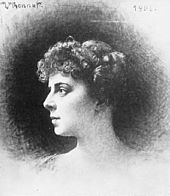La Bonne Chanson (Fauré)
La Bonne Chanson, Op. 61, by Gabriel Fauré, is a song cycle of nine mélodies for voice and piano. He composed it during 1892–94; in 1898 he created a version for voice, piano and string quintet.[1] The cycle is based on nine of the poems from the collection of the same name by Paul Verlaine.[2] According to Fauré himself, the song cycle contains a number of musical themes which recur from song to song. He had devised this technique for the 1891 song cycle Cinq mélodies "de Venise",[3] which was also based on Verlaine's poetry.[4]
Composition

Much of the cycle was composed in the summers of 1892 and 1893 while Fauré was staying in Bougival,[5] as the guest of the banker Sigismond Bardac and his wife, the soprano Emma Bardac.[6] Fauré was in love with her (although she later married Claude Debussy).[2] Fauré wrote later that the cycle was his most spontaneous creation, with Bardac singing the newly composed material for him each day.[5] The final song, "L'hiver a cessé", was completed in February 1894,[7] and the cycle was published by Hamelle that year, with a dedication to Emma Bardac.[1]
In a 1902 interview conducted by Louis Aguettant for Le Courrier musical,[8] Fauré enumerated five main musical themes which recur throughout the cycle until they appear together in the final song, "L'hiver a cessé". One of these themes was taken from his earlier mélodie "Lydia",[9] Op. 4, No. 2 (c. 1870);[10] Fauré stated that he associated this theme with a singer, possibly meaning Emma Bardac.[11]
Settings
Fauré's settings are as follows:[1]
- "Une sainte en son auréole"
- "Puisque l'aube grandit"
- "La lune blanche luit dans les bois"
- "J'allais par des chemins perfides"
- "J'ai presque peur, en vérité"
- "Avant que tu ne t'en ailles"
- "Donc, ce sera par un clair jour d'été"
- "N'est-ce pas?"
- "L'hiver a cessé"
Fauré's ordering of the settings does not correspond to that of their appearances within Verlaine's collection of 21 poems.[7]
Premieres
La Bonne Chanson had a private premiere at the residence of the Countess de Saussine on 25 April 1894, sung by Maurice Bagès.[8] Its first public performance was at the Société Nationale de Musique on 20 April 1895, sung by Jeanne Remacle. Fauré was the pianist.[1] The work was not well received by the musically conservative audience.[12] Camille Saint-Saëns declared that Fauré had gone mad.[13] In contrast, Marcel Proust, who was at the private premiere in 1894, wrote that he adored it.[12]
The string quintet version was premiered in London,[14] on 1 April 1898 at the house of Frank Schuster, with Bagès and Fauré performing.[1]
In 1918 Fauré adapted and extended a brief section from "Une sainte en son auréole" to produce Une châtelaine en sa tour, Op. 110,[15] a work for solo harp dedicated to the harpist Micheline Kahn. She premiered the work at the Société Nationale de Musique on 30 November 1918.[16]
Recordings
- Charles Panzéra and Magdeleine Panzéra-Baillot (1936) French HMV
- Suzanne Danco and Guido Agosti (1952), Decca
- Pierre Mollet and Simone Gouat (1954), Accord
- Hugues Cuénod and Martin Isepp (1973), Nimbus Records
- Sarah Walker and the Nash Ensemble (1980), CRD Records
- Bernard Kruysen and Noël Lee (1986), Astrée
- Gérard Souzay and Dalton Baldwin (1989), Philips
- Anne Sofie von Otter and Bengt Forsberg (1996), Deutsche Grammophon
- Wolfgang Holzmair and Gerard Wyss (1996), Philips
- Sanford Sylvan and David Breitman and the Lydia String Quartet (1996), Nonesuch Records
- Christopher Maltman and Graham Johnson (2002-04), Hyperion
- Verena Rein, soprano and Čiurlionis Quartet and Sergejus Okruško, piano (2005), Dreyer • Gaido
- Erin O'Meally, Soprano and Kevin Korth, Piano (2016) San Francisco Conservatory of Music
References
- ^ a b c d e Orledge (1979), pp. 296–297
- ^ a b LA Phil webpage
- ^ Orledge (1979), pp. 78–81
- ^ Orledge (1979), p. 295
- ^ a b Orledge (1979), p. 15
- ^ Nectoux (2004), p. 180
- ^ a b Orledge (1979), p. 81
- ^ a b Nectoux (2004), p. 187
- ^ Orledge (1979), pp. 81-84
- ^ Orledge (1979), p. 278
- ^ Nectoux (2004), p. 188
- ^ a b Orledge (1979), p. 84
- ^ Orledge (1979), p. 35
- ^ Nectoux (2004), p. 186
- ^ Orledge (1979), p. 170
- ^ Orledge (1979), p. 314
Sources
- "La bonne chanson". LA Phil (Los Angeles Philharmonic). Archived from the original on 29 February 2012. Retrieved 5 April 2011.
- Nectoux, Jean-Michel (2004). Gabriel Fauré: A Musical Life. Cambridge: Cambridge University Press. ISBN 0-521-61695-6.
- Orledge, Robert (1979). Gabriel Fauré. London: Eulenburg Books. ISBN 0-903873-40-0.
External links
- La bonne chanson: Scores at the International Music Score Library Project
- French texts and English translations at The Lied, Art Song, and Choral Texts Page
